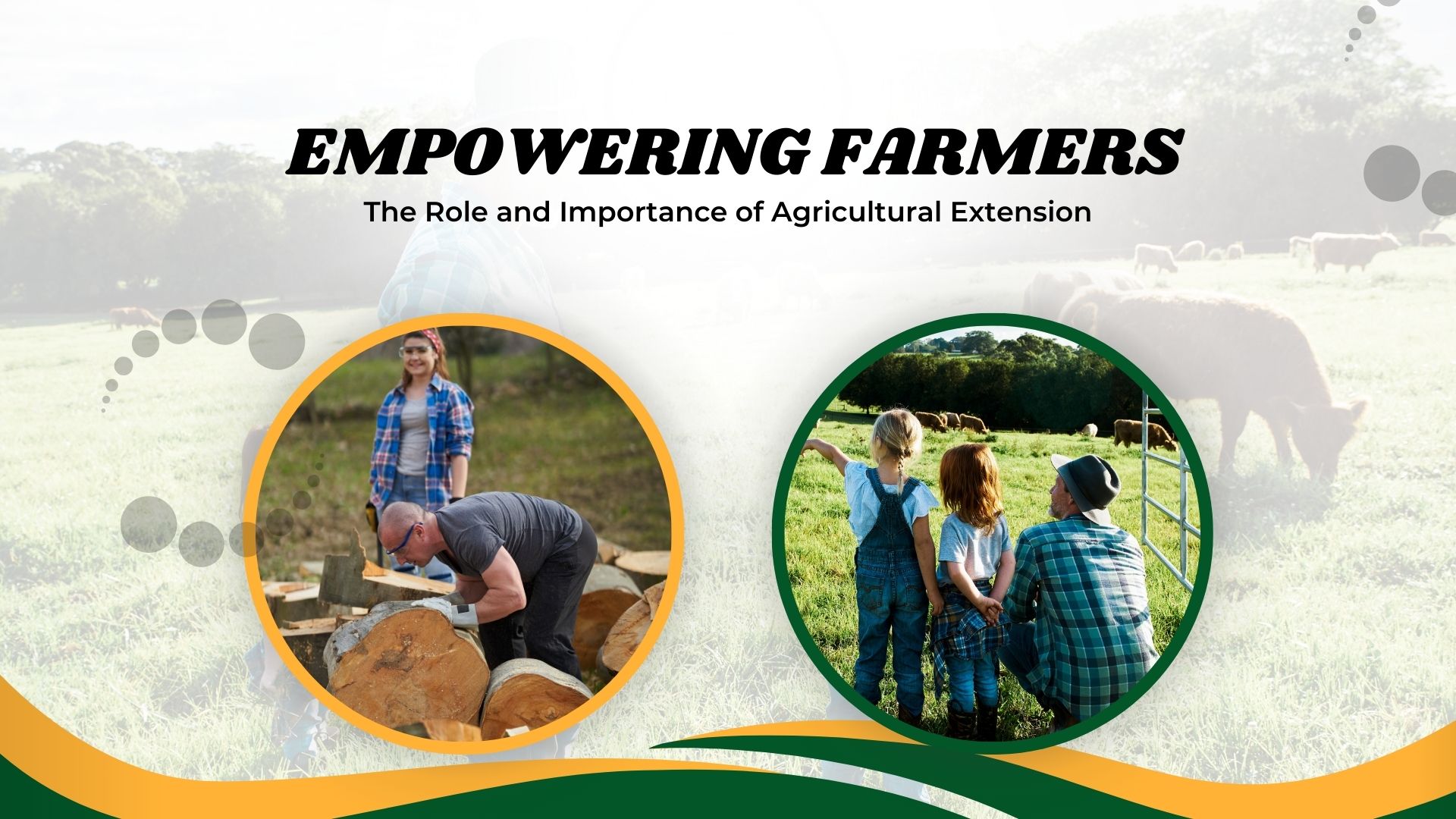
Introduction
Agricultural extension is the foundation of modern farming, providing crucial support to farmers by spreading knowledge, training, and innovative practices. This service helps enhance productivity, sustainability, and livelihoods, making it an indispensable part of agricultural development. In this blog, we will explore what agricultural extension is, its significance, various methods used,leading organization, and its impact on farming communities.
Definition and Scope of Agricultural Extension Services
Agricultural extension services are defined as “the entire set of organizations that facilitate and support people engaged in agricultural activities to solve problems and to obtain information, skills, and technologies to improve their livelihoods and well-being” (Davis, Babu, & Ragasa, 2020).
The Role of Agricultural Extension Services
Agricultural extension programs play a vital role in addressing rural poverty and food insecurity by transferring technology, supporting rural adult learning, and helping farmers solve problems. Defined by the FAO as systems that provide farmers with access to knowledge, information, and technologies, these programs facilitate interactions with research, education, and agribusiness partners.
They also help farmers develop technical, organizational, and management skills. Agricultural extension is essential for improving the efficiency and effectiveness of agriculture, promoting the safety and quality of agricultural products, and supporting rural development efforts. As a key component in technology transfer, agricultural extension significantly contributes to both agricultural and rural development.
Agricultural extension services aim to improve farmers’ productivity and sustainability by providing them with the latest knowledge, techniques, and technologies. These services can be offered by government agencies, universities, NGOs, and private companies, focusing on:
- Dissemination of information
- Education and training
- Advisory services
- Facilitation and linkage
- Problem-solving
Historical Perspective
The modern extension service began in Ireland in the mid-19th century. Between 1845-51, the Irish potato crop failed due to fungal diseases, causing a severe famine. The British Government sent “practical instructors” to rural areas to teach farmers alternative crops. This model inspired similar systems in Germany, Denmark, the Netherlands, Italy, and France by the end of the century.
The 1960s witnessed the Green Revolution in India. Agricultural extension was pivotal in spreading new knowledge and technology to farmers, introducing the “Transfer of Technology” concept.By the 1980s and 1990s, the approach became more decentralized and involved farmers in decision-making. NGOs and voluntary agencies also played a key role in promoting sustainable farming practices.
Currently, efforts focus on linking research institutions, extension agencies, and farmers. Farmer-centric approaches, like farmer field schools and participatory rural appraisals, are popular. The emphasis has shifted to sustainable agriculture, organic farming, and climate-smart practices to ensure food security and address environmental challenges
Agricultural extension has a rich history, evolving over the decades to meet the changing needs of farmers. Originally focused on simple information sharing, it has now embraced advanced technologies and methodologies to offer comprehensive support.
Methods of Agricultural Extension
Field Visits and Demonstrations: Extension workers visit farms to demonstrate new techniques and technologies.
Workshops and Training Programs: Organized sessions to educate farmers on various agricultural practices.
Publications and Media: Use of newsletters, radio, and television to disseminate information.
Digital Tools and Mobile Apps: Modern tools for remote advisory services, weather forecasts, and market trends.
Success Stories Examples
India’s Green Revolution
In the 1960s and 70s, agricultural extension played a key role in India’s Green Revolution, helping farmers adopt high-yielding varieties of seeds, modern irrigation practices, and chemical fertilizers, leading to a significant increase in food production.
Kenya’s Digital Extension Services
Kenya has embraced digital extension services, using mobile apps to provide farmers with real-time information on weather, pest management, and market prices, significantly improving their productivity and income.
Challenges in Agricultural Extension
- Limited resources and funding
- Accessibility issues in remote areas
- Keeping up with rapid technological advancements
- Ensuring the relevance of information to diverse farming contexts
Future Prospects
The future of agricultural extension lies in integrating advanced technologies such as artificial intelligence, big data analytics, and remote sensing. These innovations can provide personalized and precise advice to farmers, ensuring higher productivity and sustainability.
Leading Organizations and Approaches in Agricultural Extension Services
Agricultural extension agencies in developing countries receive large amounts of support from international development organizations such as the World Bank and the Food and Agriculture Organization of the United Nations.
Leading Organizations Providing Agricultural Extension Services
Food and Agriculture Organization (FAO)
Scope: International
Role: Strengthening the capacity of agricultural extension services worldwide.
United States Department of Agriculture (USDA):
Scope: National (USA)
Role: Research-based information dissemination through the Cooperative Extension System.
International Fund for Agricultural Development (IFAD)
Scope: International
Role: Supporting extension services in rural areas of developing countries.
World Bank
Scope: International
Role: Supporting various projects and initiatives to improve agricultural extension services.
National Institute of Agricultural Extension Management (MANAGE)
Scope: National (India)
Role: Providing extension management training and advisory services.
Consultative Group on International Agricultural Research (CGIAR)
Scope: International
Role: Offering extension services and research to enhance agricultural productivity.
Examples of Agricultural Extension Approaches
Krishi Vigyan Kendra (KVK)
Description: District-level centers in India created by the Indian Council for Agricultural Research (ICAR) to provide various types of farm support.
Focus: Localized, hands-on support and training for farmers.
Market-led Extension
Description: Helps farmers understand market demands and consumer preferences to improve their livelihoods.
Focus: Market intelligence, contract farming, direct marketing.
Example:The Kenya Agricultural and Livestock Research Organization (KALRO),works to develop and promote agricultural technologies that are driven by market needs
Participatory Extension
Description: Combines technology transfer, advisory services, and human resources development, involving all types of farmers, especially small-scale and women.
Focus: Inclusive, farmer-centered development and knowledge sharing.
Example:The Deccan Development Society (DDS)in India. DDS involves local farmers, especially women, in the decision-making process to improve agricultural practices.
Cyber Extension
Description: Uses information and communication technologies to disseminate agricultural information.
Focus: Technology-driven, broad dissemination of knowledge.
Example: The e-Choupal initiative by ITC Limited in India. e-Choupal uses internet technology to provide farmers with real-time information and customized knowledge on weather, prices, and best practices.
Farmer-led Extension
Description: Training provided by farmers to other farmers.
Focus: Peer-to-peer learning and community-based knowledge transfer.
Conclusion
Agricultural extension is important for the growth and sustainability of agriculture. By empowering farmers with the knowledge and tools they need, it helps build strong farming communities and ensures food security. As we look to the future, embracing new technologies and methods will further enhance the impact of agricultural extension, making it an even more powerful tool for agricultural development.
Call to Action
If you are a farmer or involved in agriculture, don’t hesitate to reach out to your local agricultural extension services to learn more about the support available to you. By working together, we can build a more sustainable and productive agricultural sector.
The Importance of Agricultural Extension Services at AgriNext Awards, Conference & Expo
Agricultural extension services play a crucial role in bridging the gap between scientific research and practical farming. These services provide farmers with the knowledge and tools necessary to improve their productivity, sustainability, and economic viability. At the AgriNext Awards Conference & Expo the focus on agricultural extension services underscores the event’s commitment to fostering innovation and supporting the agricultural community.
The principles and benefits of agricultural extension services are woven throughout the conference. For instance, the emphasis on AI and digital transformation in farming practices aligns with the goals of agricultural extension by making advanced technologies accessible to farmers. Additionally, exhibitors like Zodi and Algofait highlight the event’s commitment to fostering innovation and providing farmers with cutting-edge solutions.
By including principles of agricultural extension services into its agenda, AgriNext demonstrates its dedication to empowering farmers and advancing the agricultural sector. Whether through presentations, workshops, or networking opportunities, the conference offers a platform for sharing knowledge and driving progress in the field of agriculture. Emphasizing principles such as participatory approaches, market-led initiatives, and cyber extension, AgriNext ensures that farmers receive the latest information and support needed to enhance productivity and sustainability.
Signup For AgriNext Conference Newsletter

